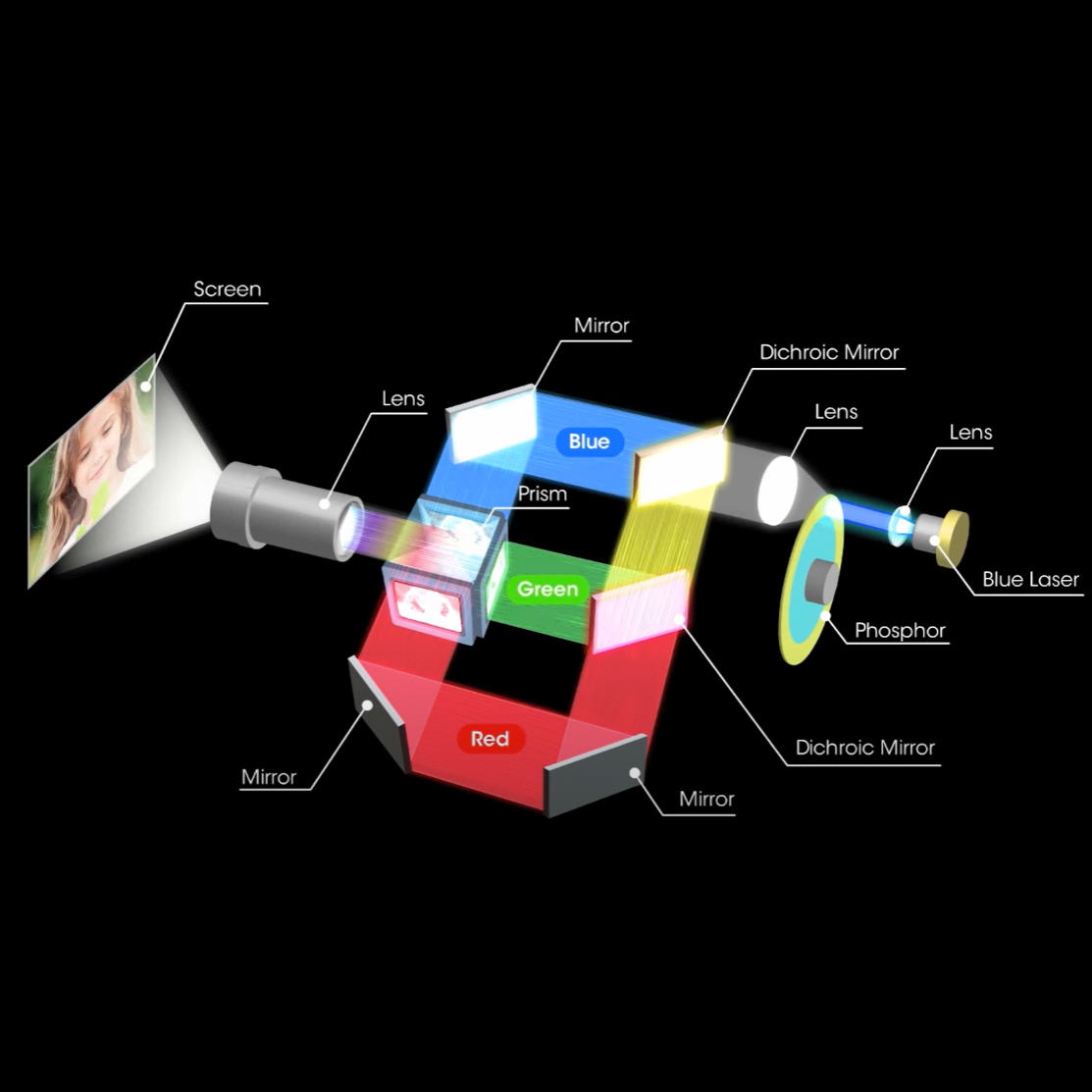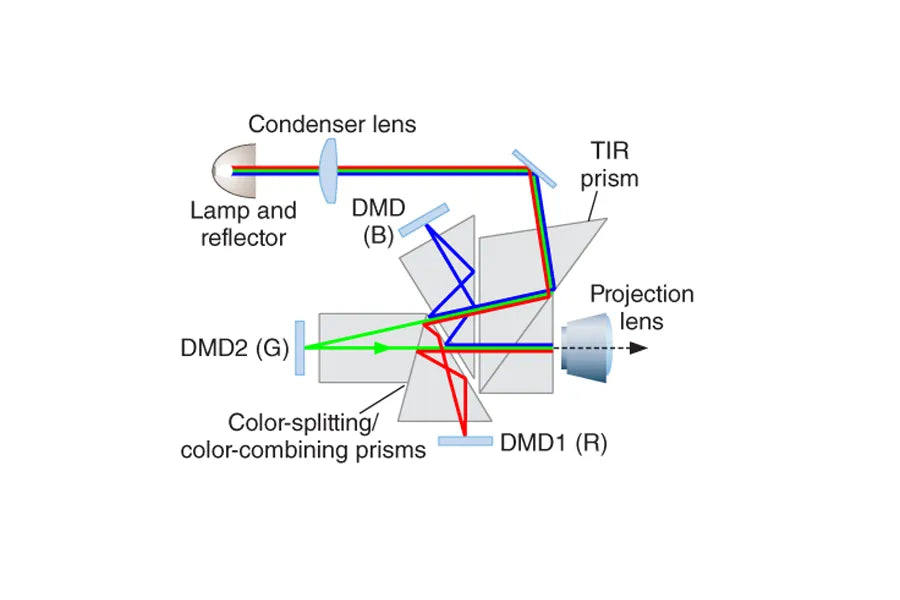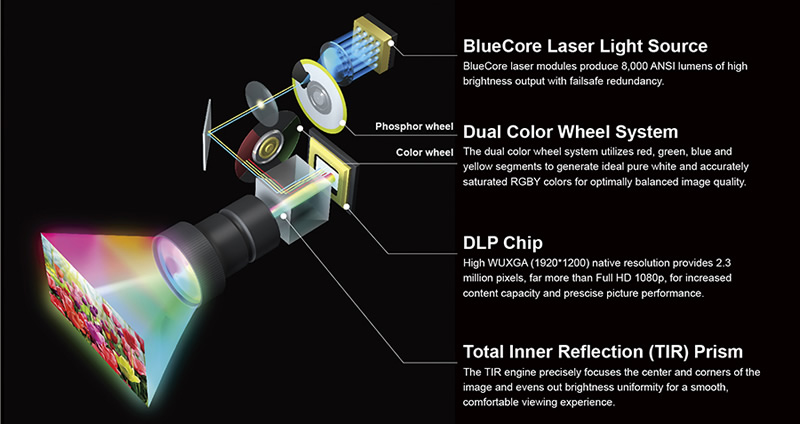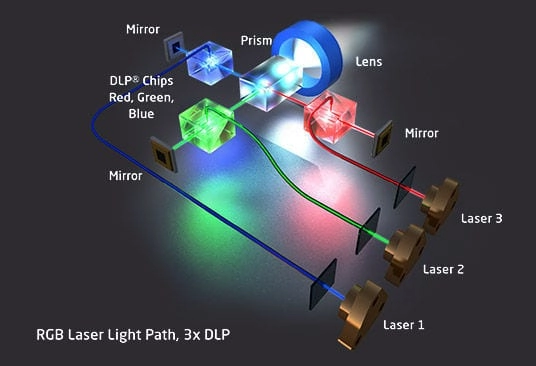DLP, LCD, or Laser: Which Projector Is Better?
What is a DLP Projector?
How Does it Work?
- DLP projectors are compact and easy to transport for work or enjoyment wherever you go
- DLP projectors provide the best contrast for home theaters and deep blacks to make the movie come alive
- DLP projectors generate clean images without a grid so text and fine detail are sharp and legible
- You may see a rainbow effect on DLP projectors so it is important to test if you are light sensitive
- DLP projectors look good in a dark room but may wash out in bright, sunny places
- Color in DLP projectors may be slightly off, making them less desirable for work where color matters, such as photo editing or design.
What is an LCD Projector?
How Does it Work?
- Bulky and Heavy: LCD projectors require three panels as opposed to a single chip, making them large and heavy. If you are looking for a portable projector for travel or camping, LCD is not the best option.
- DLP projectors offer the best contrast for home theaters, with deep blacks that bring movies to life.
- DLP projectors deliver smooth, grid-free images, making text and fine details crystal clear.
- Some users may notice a rainbow effect on DLP projectors, so test for light sensitivity before buying.
- Lower Contrast Than DLP: LCD projectors have difficulties rendering deep blacks due to light leaking through, which results in a grey-ish shade on dark movie scenes. This is fine for casual viewing with friends, but for home theater enthusiasts, DLP may be the way to go.
- Color Combination & Projection: After each LCD panel has worked on the color, the beams combine into one full-color image. The prism is what successfully blends the light and detail, and is then followed by the lens to deliver bright true to life color on the screen.
What is a Laser Projector?
How Does it Work?

Laser projectors have exceptional performance.,With their extra brightness (5,000-10,000 lumens), they are great for outdoor uses, bright rooms, and large spaces.
Most options are great because they require very little maintenance, laser diodes last 20,000-30,000 hours, far longer than any bulbed or LED wear and tear, thus saving time and cost on replacements. Powering up and powering off is instant—unlike bulbed projectors which need warm-up time.
Some laser DLP models do not experience rainbow effect inducing unsightliness for viewers, making for a more comfortable experience for sensitive eyes.
Cons of Laser Projectors
The biggest disadvantage is price! Most folks are looking at 1,000 starting price point to 5,000 plus for a premium projector. If you can swing the costs, that’s great!
Another disadvantage is size and weight, compared to the laser LED project, they tend to be bulkier for the extra cooling needed and portability varies greatly.
Some users experience what appears to be a speckle effect on a flat wall. Usually a proper projector screen will eliminate the issue.
Differences Between LCD, Laser, and DLP Projectors
Feature | DLP Projector | LCD Projector | Laser Projector (DLP/LCD) |
Core Tech | DMD chip (mirrors) + LED/bulb | 3LCD panels (transmissive) + LED/bulb | Laser diode + DMD/LCD |
Brightness (Lumens) | 2,000-4,000 | 3,500-5,000 | 5,000-10,000 |
Color Accuracy | Good (minor 偏差) | Excellent (true-to-life) | Excellent (saturated) |
Contrast | High (deep blacks) | Medium (gray blacks) | High (if laser DLP) / Medium (if laser LCD) |
Portability | Very light (1-3 lbs) | Heavy (5-8 lbs) | Heavy (4-8 lbs) / Rare portable options |
Lifespan | 5,000 (bulb)–15,000 (LED) hours | 5,000 (bulb)–20,000 (LED) hours | 20,000–30,000 hours |
Rainbow Effect | Possible (10-15% of users) | None | None |
Price Range | 300–2,000 | 500–3,000 | 1,000–5,000+ |
Best For | Portability, home theater, 3D | Color work, classrooms, bright rooms | Outdoor use, offices, long-term setups |
Spotlight on Toumei DLP Projectors
Ultra-Portable
GTV & KTV Ready
Built-In Battery
Short-Throw Distance
Conclusion
Laser projectors are typically brighter than standard DLP projectors with a higher lumen output, making them better if you're working in a well-lit room or hosting an event in a large auditorium.
DLP projectors are also favored for video gaming, they provide fast response times and inherently have low input lag. However, in terms of speed and brightness, laser DLP projectors are the best option for serious gamers.
Yes, DLP projectors typically offer sharper images, better in improving contrast, and smoother motion images than LCD projectors. LCD projects are less expensive, but DLP offers better images and visual performance overall.
Most portable DLP projectors with a built-in battery last 2–4 hours on a full charge depending on brightness settings and the way they are used.







